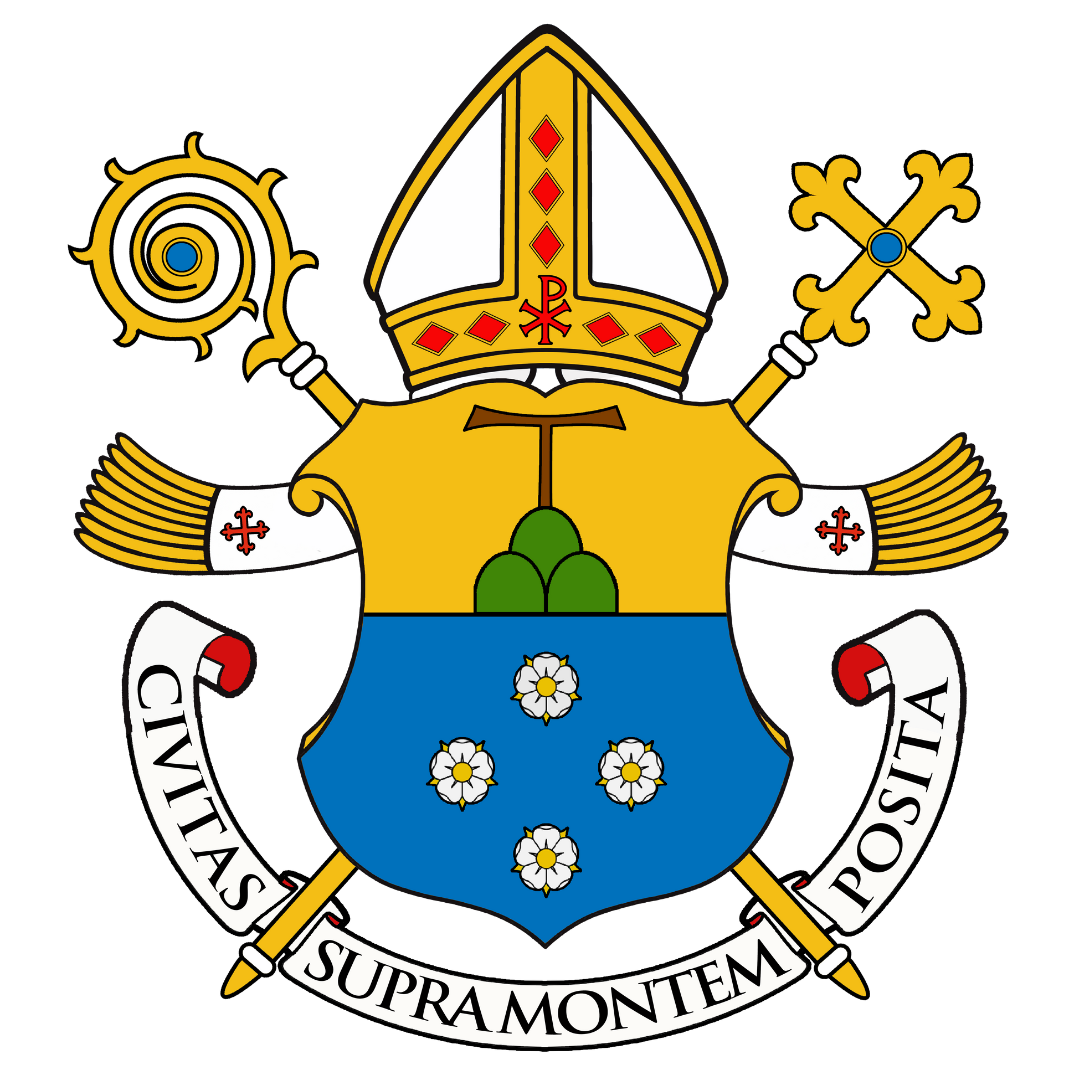
The Coat of Arms of the Diocese of Cubao
BLAZON
Azure (blue), Chief Or (gold). In Chief, a Tau Cross Tawny (brown) proper atop a mount of three coupeaux Vert (green). In Base, four cinquefoils Argent (white) with leaves Or (gold) arranged as a lozenge.
HONOR POINT
A Tau Cross in Tawny (brown) is placed in a mount of three coupeaux Vert (green) on an Or (gold) field. The mount represents the hills that are reminiscent of the original landscape of Quezon City which geographically constitutes the Diocese of Cubao. Quezon City was built on hills. In the Scriptures, hills and mountains are the dwelling places of the Divine. They are places where man encounters God. Jesus himself was always found on a hill communing with the Father. Hills and mountains are thus symbols of God's presence. They are also symbols of prayer and contemplation where man encounters God in silence. The three hills symbolize the Trinity after which the communion of the three sectors of Cubao - Clergy, Religious, and Lay, or the Santatlo as we call them, is patterned.
The Tau cross on top of the hill depicts the missionary character of the diocese. It reminds us of the Franciscan missionary and martyr, San Pedro Bautista, who founded the first missions in San Francisco del Monte in the late 1500's before he was martyred in Japan. The cross is the symbol of Christ and his sacrificial love for us. Thus, the Tau cross is a symbol of that merging of Christ's self-offering and our desire to imitate his love and service. The Tau cross on top of the hill echoes the words of Christ in Matthew 5: "Civitas supra montem posita non abscondi" – A city set on a hill cannot be hidden." The Diocese of Cubao envisions a community of disciples that will shine forth through its faithful and loving witness to Christ.
The Or (gold) field suggests light radiating from the cross. The birth of the diocese is light that exudes in Quezon City. Christ who overcomes all things has overcome the darkness of sin that we may have the Light of Life. The entire image in the honor point is a symbol too of what the parishes of the Diocese of Cubao, truly want to become: a Church that has experienced – and is set to witness to - the living presence of God, the empowering sacrifice of Christ, and the animating light of the Holy Spirit.
NOMBRIL POINT
The Azure (blue) tincture and four cinquefoils Argent (white) are symbols of Mary, the Patroness of Quezon City, Nuestra Señora del Santissimo Rosario - La Naval de Manila, and the titular of the Cathedral of Cubao- the Immaculate Conception of the Blessed Virgin Mary, the same Patroness of Manila, the mother diocese, and of the whole Philippine archipelago.
Historically, Quezon City has a strong Marian tradition. On August 21, 1973, through a resolution, the City Government adopted "Our Lady of the Rosary of La Naval" as the Patroness of Quezon City. To officially celebrate the occasion, a Holy Mass was held on October 12, 1973 during the 34th Founding Anniversary of Quezon City. His Holiness Pope Paul VI formally approved this motion at the request of the City Council and the Archdiocese of Manila through a decree by the Sacred Congregation for the Divine Worship on August 26, 1974.
But even before this took place, the first chapel that was constructed by the Franciscans in 1590 in San Francisco del Monte was dedicated to Our Lady of Montecelli. In 1892, the Capuchins opened a public chapel dedicated to the Mother of the Divine Shepherd or Divina Pastora. In this same chapel was placed the image of Our Lady of Lourdes. Due to the many devotees of Our Lady, the Confraternity of Our Lady of Lourdes was founded. In 1898, a bigger church was constructed and was dedicated to Our Lady of Lourdes.
Furthermore, the cinquefoils Argent (white) also complement the cinquefoils in the coat-of-arms of the Archbishop of Manila, Jaime Cardinal Sin. We attribute our devotion to the Virgin Mary to the precious heritage of the beloved Archbishop. Providentially, the establishment of the new Diocese of Cubao coincides with the celebration of the Year of the Rosary declared by Pope St. John Paul II. The cinquefoils bring to mind the mysteries of the Rosary with the new Mysteria Lucis. These mysteries of the Rosary symbolized by the four cinquefoils, as Pope St. John Paul II puts it, "are resplendent with the Mystery that surpasses all understanding: the Mystery of Christ, the Word made flesh, in whom all the fullness of God dwells." (Pope John Paul II, Rosarium Virginis Mariae, no. 24)
In this present iteration of the coat of arms of the Diocese, a number of additional symbols were placed in the supporters of the shield. In the miter of the coat of arms, the Chi Rho in Gules (red) is placed at the center of the miter to represent the First Bishop of Cubao, the Most Reverend Honesto F. Ongtioco, D.D. The cross in the bishop's coat of arms has been formed into this symbol. The seven lozenges in Gules represent the Seven Gifts of the Holy Spirit - Wisdom, Understanding, Counsel, Fortitude, Knowledge, Piety, and Fear of the Lord. Each of these gifts is a call for the clergy, religious, and the faithful of the Diocese to be "docile in readily obeying divine inspirations" (Catechism of the Catholic Church, no. 1831). The Cross and Crozier crossed together signify the authority of the Bishop over the Diocese and emphasizes the role of the local Church to be a community of Christ's disciples.

